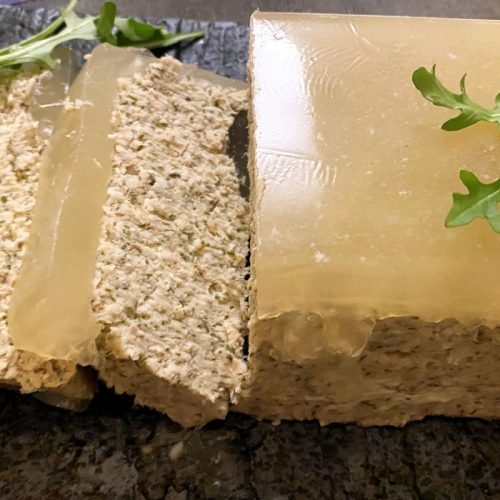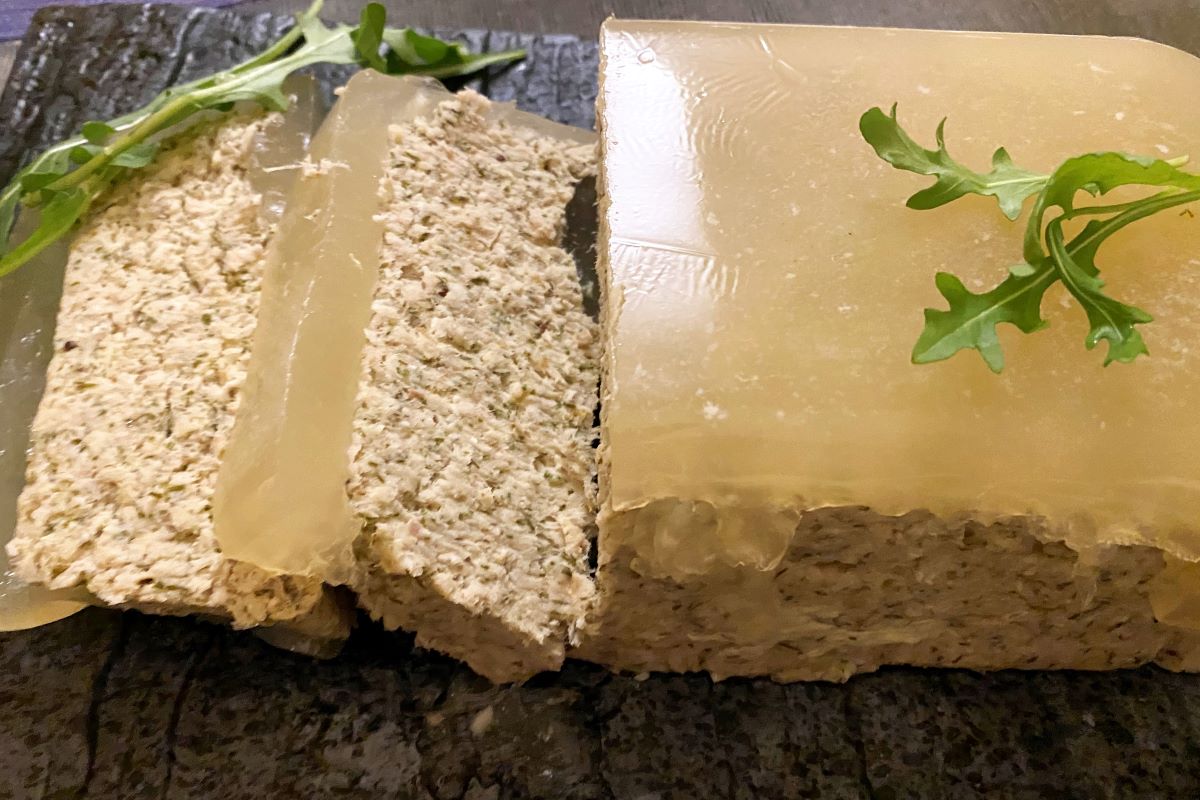White fish pate in aspic is the ultimate way to eat a delicious fish dish, prepared in advance. The aspic is prepared after the bake and provides protection but also complements the taste. Use a smoked fish, like smoked mackerel, to mix with the white fish to develop intense taste. Perhaps against your intuition, this dish must be prepared 2-3 days in advance and matured in the refrigerator. Therefore it is very suitable for a lunch or dinner with multiple guests. All you need to do is cut the pate in slices!
The art of making white fish pate in aspic
The effort to make this wonderful dish is considerable, but the reward is high! First we will poach the white fish in a poaching broth at 150-160 F (65-70 C), each fish for around 20-25 minutes. At this relatively low temperature the fish proteins will set, yet much of the precious taste and fats will be preserved. Also it will be very easy to clean the fish meat from the bones afterwards. We reserve the carcasses. Then we will make the mixture for the pate, with fresh dill, some creme fresh or sour cream and eggs in the meat grinder. We will bake the fish pate in the oven, en-croute, i.e. enveloped by a dough, to preserve the flavor and moisture content and to protect the fish from a too high temperature. The pate is refrigerated overnight under weight. Then we will make the aspic, by extracting fish gelatin from the carcasses and the next day add some pig gelatin or alternatively agar-agar -if you object to pork-. After removing the baked dough, we add the aspic and let it set. Let the pate mature for one or two more days to develop more taste.
Special equipment
- meat grinder
- thermometer (up to 212 F, 100 C)
- pate form
- dough pin

White fish pate in aspic
Ingredients
Ingredienten voor het vismengsel
- two 10 oz (300 g) pomfrets (total around 20 oz or 600 g) or other white fish with bones
- 6 oz (170 g) warm smoked mackerel
- a bunch of fresh dill
- 4 tsp sea salt flakes
- 1/2 tsp ground pepper
- 2 tsp brandy
- 1 tbsp Pernod, Ricard, Rakki or Ouzo (anice liquor)
- 1 tbsp (gedroogde) dragon
- 3.5 oz (100 g) creme fraiche of sour cream
- 2 eggs
- 1/2 carrot
- 2 stalks of celery
- 1 middle sized white onion (9 oz or 250 g)
- 1 tbsp fresh lemon juice
- 2 tbsp olive oil
- 5 cups water
- 1 bay leave
Ingredients for the dough (see also our recipe Salmon pate en-croute)
- 3.5 oz (100 g white flour (and some extra for rolling)
- 2.4 oz (69 g) water
- 1/2 tsp flaked salt
- a 3 inch wide, 20 inch long sheet of baking paper optional
Ingredients for the aspic
- all fish carcasses: bones, head, fins, tail, skin
- 2 tbsp or 1 oz or 30 g pig gelatin may be replaced by agar agar
- 3-4 cups fish broth
- pinch of salt
Instructions
Preparing the fish mixture
- First work on the dough (see below)
- Start with making a simple broth using the water, the carrot, the celery and 2 tsp of salt by heating the mixture and simmering for 20 minutes
- Take the tails off the fish and reserve. Place one fish in the broth and keep it at 65-70 C for 15-20 min. Take out and repeat with the other fish
- Let the fishes cool down a bit and remove the skin and then remove the fish meat. Reserve the fish meat. Keep the skin, and the bones with the tails and reserve. Also reserve the broth
- Cut up the onion and briefly fry it in a skillet with some oil and then smother for 15 min at low fire. Let cool down and reserve
- Meanwhile wash the dill, dry and remove the stalks. Cut very fine.
- Mix the reserved white fish meat, the smoked mackerel, the onion, the dill, the tarragon, the salt, pepper, brandy, the ricard and the lemon juice. Keep it cool or cool it down in the freezer or refrigerator
- Grind the mixture through the course and then through the fine mesh of the grinder
- Cool the mixture down, if needed in between
- Mix the eggs and the creme fresh in a separate bowl with a whisk or fork.
- Mix in the egg cream mixture in the ground fish mixture and pass one more time through the fine mesh of the grinder
- Fill the dough covered terrine with the ground fish mixture. Close the surface with the flap of the dough. Make two small holes in the dough surface so that moisture and steam can be released
Making the dough
- Mix flour, salt and water and insure all the flour is absorbed by continuously folding and pressing the dough. if the dough is still too moist to the touch add a bit more flour and then make a ball
- Let stand covered at room temperature for at the least 1 hr
- Thereafter, on a floured surface, stretch the dough, fold it, stretch and press it. In short knead it. Do this for 10 min and make a ball
- Use olive oil or other vegetable oil to brush the inside surface of the terrine with. Then place the baking paper sheet over the longer side in the terrine to aid release after baking. The latter is optional
- Just before filling the terrine, place the dough on a floured surface and use the dough pin to roll the dough out in a thin layer. Cut pieces out to cover the walls of the terrine and have the dough on one long side be longer, so it can be folded onto the surface later
Baking the pate
- Place the terrine without a lid in the pre-heated oven at 180 C for 45 min
- After this take the terrine out of the oven and place a hard inert surface on the dough covered pate. Place a 3 lb weight on this. Some juices may appear. Let it cool down and then place in the refrigerator with the weight on at the least overnight or a full day
- To release the pate, use a paring knife to cut between the paper (or dough) and the terrine sides. Lift the pate from the terrine using the baking sheet or when not used place the terrine upside down on a wooden cutting board.
- Remove the baked dough cover and keep the pate cold
Preparing the aspic
- Use the left-over fish carcasses, the skin, the tail etc to steep into the fish broth. Do this for 25 min at 80-85 C. Thereafter sieve the broth let cool down and place overnight in the refrigerator. Discard the fish and vegetable remainders
- The next day heat the gelled fish broth and prepare the pig gelatin. Add the gelatin to the clear broth and mix
- Let the broth further cool down
Enveloping the pate with aspic
- Clean the terrine and place three 1/5 inch (0.5 cm) thick pieces of cellery stalk on the bottom to support the fish pate. Place the fish pate on the stalks in the terrine. The stalks will cause the pate to be clear from all terrine sides.
- Add the gelatin loaded fish broth over the pate and ensure the pate is covered
- Place in the refrigerator for at the least one more day
- Before serving, cut the aspic loose from the terrine surfaces with a paring knife. You can also dip the terrine briefly in hot water, so that the aspic may partially melt where it touches the terrine surface. Turn the terrine upside down on a wooden cutting board and cut slices with the aspic attached
Notes
Food allergy & intolerance information: cream, fish
Remarks
- Other white fish is also very acceptable. However, for very deep swimming or very cold water sea fish, the gel point of their gelatin lies at a lower temperature. [ref] This would result in an almost liquid aspic when you would serve the dish. In such case rely more on the pig gelatin to set the aspic.
- Remember: tasty fish provides a tasty fish pate. Using Pangasius fish for example, which has little taste in general, would cause the pate taste more flat. But as a tropical fish, the Pangasius’ gelatin would contribute to setting the aspic.
- The ultimate taste of the aspic consists of the fragrance and smell, but equally so is influenced by the way it melts in your mouth. Here it becomes important to use the right mix of fish gelatin and pig’s gelatin. Pig’s gelatin alone makes the melting point of the aspic too high. Agar will have a slightly different effect, but is still acceptable.



